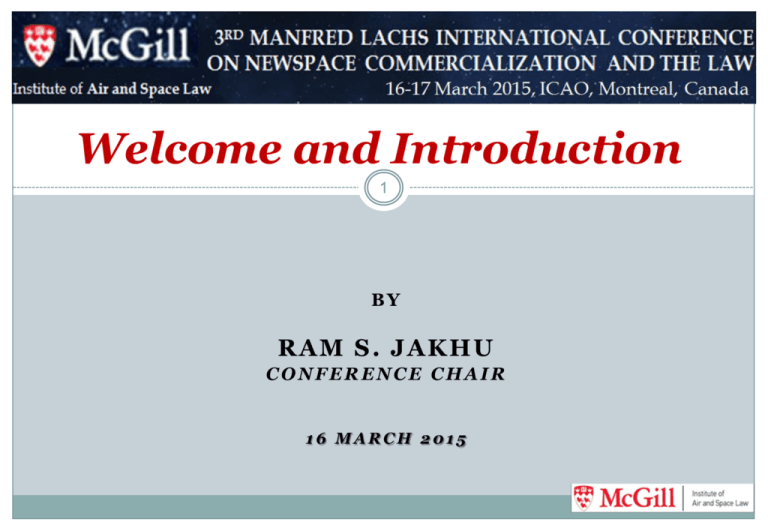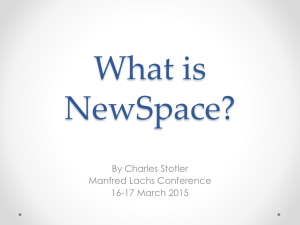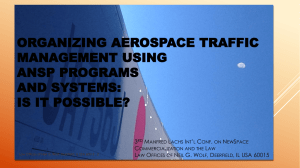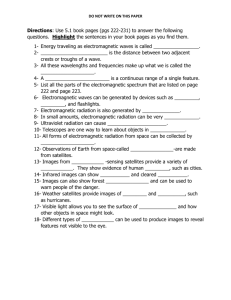intro - McGill University
advertisement

Welcome and Introduction 1 BY RAM S. JAKHU CONFERENCE CHAIR 16 MARCH 2015 Purpose of this presentation 2 The purpose of this presentation is to set the stage for deliberations at the 3rd Manfred Lachs Conference on the theme of NewSpace Commercialization and the Law. I intend to explain briefly: the rationale, the objective some basic facts and trends, and the format of the Conference Rationale of the Conference 3 The term ‘NewSpace’ is commonly used within the industry, regulatory and policy circles pertaining to new commercial space activities. Although difficult to precisely define, several themes appear to apply clearly to the NewSpace movement: disruptive technologies, entrepreneurship, privately held companies, individual access to and settlement of space and exploitation of space resources. Charles Stotler will be presenting an excellent paper on the meaning and scope of the term NewSpace. According to Dr. Joseph Pelton, NewSpace is much more than new commercial space activities. Rationale of the Conference 4 NewSpace ventures exist across spectra of sizes, structures and funding sources, ranging amongst: (a) truly new start-ups, some working out of their garages, some backed by venture capitalists and others funded by Public-Private Partnerships, including companies such as Nanoracks, Skybox, and Made In Space; (b) new enterprises with billion dollar backing such as Bigelow Aerospace, Blue Origin, SpaceX and Virgin Galactic; (c) older enterprises finding new traction in a newly commercialized era & benefiting from new technologies, including companies such as Orbital Sciences, Boeing and Lockheed Martin; Rationale of the Conference 5 (d) new alliances of newer & older players, like Stratolaunch & Blue Origin’s partnership with United Launch Alliance; and (e) non-space companies making inroads into the NewSpace paradigm, such as Google’s recent purchase of Skybox, illustrating that space and technologies developed in space have the potential to affect every aspect of life on Earth. NewSpace commercialization is making space less rocket science Through innovative technologies, new business initiatives, new players, new production techniques and new products, NewSpace revives unresolved legal issues & brings forth new legal challenges Legal and regulatory certainty is imperative for enabling NewSpace as it has been for the expansion of OldSpace. Some basic facts and trends 6 UCS: Satellite Quick Facts (launches through 31 January 2015) Total number of operating satellites: 1,265 US: 528 LEO: 669 Russia Other: China: 132 : 131 474 MEO: 94 Elliptical: 37 GEO: 465 Private sector already operates more satellites than governments Commercial space sector is expanding rapidly 7 Global space economy grew from $164 billion in 2004 to $320 billion in 2013. Signs of a Satellite Internet Gold Rush in Burst of ITU Filings Peter B. de Selding , (January 23, 2015): http://spacenews.com/signs-of-satellite-internet-gold-rush/ 8 Canada: CANPOL-2 up to 72 satellites in different orbits & in VHF-, UHF-, X- & Ka-band Canada: COMSTELLATION, 794 satellites in LEO in Ka-band France: Thales Group’s MCSat, between 800 & 4,000 satellites in different orbits & in Ku- & Ka-band Liechtenstein: 3ECOM-1, 264 satellites using Ku- & Ka-band Norway: ASK-1, 10 satellites in elliptical orbit in X-, Ku-, Ka-band Norway: STEAM-1, 4,257 satellites in Ku-band US: OneWeb to build a 650-satellite constellation US: SpaceX to build a 4,000-satellite constellation “The coordination procedures will be problematic,” one ITU official said Significant increase in smallsats (cubesats) 9 Euroconsult: Approximately 510 small satellites worth $7.4bn are planned for launch in the next five years (2 March 2015) Emerging legal and regulatory issues related to: 10 a. Shortage of radio frequencies, orbital slots & jamming b. Expanding space debris, debris mitigation, debris removal c. Small satellites, licencing, radio frequency allocations d. Increasing space militarization, space weaponization, e. f. g. h. i. commercial satellites for military purposes New and private space transportation systems and human space travel (space tourism) Launch and operation of private space stations Property rights and licencing for mining of the Moon and asteroids by private companies Attracting adequate funding and risk management Etc. etc. Increasing Space Treaties, National Laws & Regulations OECD-The Space Economy at a Glance - Oct 2014 11 Still there is a need to do more to fill-in the lacunae, to lower regulatory barriers, to increase efficiency of regulations, and to facilitate all space enterprises, especially those that attempt to join in the NewSpace movement. Objective of the Conference 12 The objective of the Conference is: to provide an enabling environment for serious, international and interdisciplinary deliberations on all relevant aspects of NewSpace Commercialization and the Law. There will be presentations related to the state of the art in current and future NewSpace activities, and the challenges they pose in terms of space policy, law and regulation. Particularly, it will seek solutions to the unsolved legal issues in order to facilitate the expansion of NewSpace activities and to promote a responsible use of space by all stakeholders. Format of the Conference 13 During the Conference, there will be 6 plenaries and 4 breakout sessions. The final concluding plenary session will be in the form of a roundtable discussion between the chairs of the previous sessions. They will present the main points of their respective sessions. There will be about 90 participants attending this Conference. There will be about 50 papers presented. The presentations will consist of papers selected from the abstracts received and the remaining are invited papers. Format of the Conference 14 Speakers are not expected to represent their countries and employers. Selected papers of the highest quality will be published in an edited book. More importantly, the papers from the Conference will be a part of the input into the “International Study on Global Space Governance," which is being conducted at the McGill Institute of Air and Space Law. This study is being coordinated & will be edited by Dr. Joseph Pelton and me. The Conference is a joint venture of 14 institutions from various countries. The Conference is financially supported by the Eric J C Arsenault Fund at the Faculty of Law. Finally my sincere thanks to: 15 All the members of the Conference Program Committee; All Collaborating Institutions; and ICAO for allowing us the use of these excellent facilities. Special thanks to: The Eric J. C. Arsenault Foundation Prof. Paul Dempsey Dr. Joseph Pelton Dr. Jinyuan Su Ms. Maria D’Amico Mr. David Kuan-Wei Chen Dr. Cassandra Steer AND to all the speakers for their time & effort in preparing their papers and travelling to Montreal. Without you all, this Conference would have not taken place. THANK YOU FOR YOUR ATTENTION 16 Thank you SAVE THE DATE FOR: 4th Manfred Lachs International Conference May 26-28, 2016 IASL, McGill University, Montreal, Canada.







